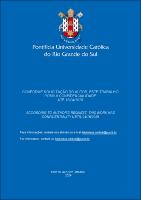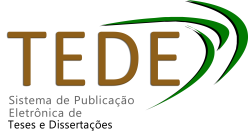| Share record |


|
Please use this identifier to cite or link to this item:
https://tede2.pucrs.br/tede2/handle/tede/11144| Document type: | Tese |
| Title: | Solventes eutéticos profundos: preparo, caracterização, extração e análise in vitro da bioatividade dos extratos de Pterocaulon polystachyum |
| Other Titles: | Deep eutectic solvents: preparation, characterization, extraction, and in vitro analysis of the bioactivity of the Pterocaulon polystachyum extracts |
| Author: | Rodrigues, Victor Hugo Silva  |
| Advisor: | Cassel, Eduardo |
| Abstract (native): | Os solventes eutéticos profundos (DES) são uma nova classe de solventes verdes e sustentáveis formados pela mistura de um sal orgânico e um composto doador de hidrogênio, destacando-se como alternativa sustentável para aplicação em processos de extração. Logo, este estudo propõe o uso de DES para a extração de compostos bioativos, cumarinas e fenólicos, de Pterocaulon polystachyum, buscando a condição ideal de extração em relação à compostos de alto valor agregado. Oito diferentes DES foram avaliados como potenciais solventes e foram preparados e caracterizados em termos de propriedades físico-químicas e térmicas. O melhor solvente foi selecionado de acordo com os resultados de quantidade de fenólicos totais (TPC) e a otimização da extração por design experimental de fator simples teve como variáveis tempo, temperatura, relação sólido/líquido e tipo de método de extração – extração assistida por ultrassom (UAE) ou aquecimento e agitação (HS). As melhores condições encontradas foram 30 min, 40 ºC, relação S/L de 1:20 e o uso de UAE foi benéfico para o rendimento da extração. Em destaque, o DES formado por ácido lático, água e glicina (Lac:Gly:Wat 3:1:3) e o DES formado por betaína e etilenoglicol (Bet:Et 1:3), ambos em proporção molar, obtiveram resultados de TPC maiores que a água e etanol, mostrando-se como boas alternativas aos solventes tradicionalmente utilizadas na indústria. Ainda, foram capazes de extrair biocompostos a partir de resíduos de P. polystachyum de outros processos de extração, reforçando o conceito de engenharia verde. Os extratos obtidos com esses DES indicaram cumarinas em sua composição pela análise de CCD e, para o DES Bet:Et 1:3, tiveram sua toxicidade testada frente a células HaCat, T24, U-87 e M059-J. Ainda que os resultados não tenham indicado a inibição do crescimento das células tumorais, mostraram potencial aplicação em formulações cosméticas, visto que os extratos não se mostraram tóxicos às células HaCat no intervalo de concentrações usualmente testado com essa finalidade (até 3 mg/mL), representando um processo novo, simples e seguro para obtenção de produtos que podem ser utilizados sem a necessidade de purificação. Adicionalmente, foi proposta uma metodologia de varredura e seleção do melhor solvente para extrair cumarinas, utilizando o modelo preditivo COSMO-RS aplicado no software COSMOtherm, onde essas ferramentas se mostraram capazes de representar a estrutura molecular dos DES e predizer suas densidades e a solubilidade da cumarina nos solventes por meio do coeficiente de atividade em diluição infinita, o que auxilia na consolidação do uso de ferramentas preditivas associadas a DES e produtos naturais |
| Abstract (english): | Deep eutectic solvents (DES) are a new class of green and sustainable solvents, formed by mixing an organic salt with a hydrogen donor compound, standing out as a sustainable alternative for application in extraction processes. This study proposes the use of DES for the extraction of bioactive compounds (coumarins and phenolics) from Pterocaulon polystachyum, aiming for the ideal extraction condition regarding the compounds with high added value. Eight different DES were screened as potential solvents and were prepared and characterized in terms of physicochemical and thermal properties. The best solvent was selected according to the total phenolic content (TPC) and extraction optimization by single-factor experimental design was performed in terms of time, temperature, solid/liquid ratio, and type of extraction method – ultrasonic assisted extraction (UAE) or heating and stirring (HS). The best extraction conditions were 30 min, 40 ºC, S/L ratio of 1:20 and the use of UAE was beneficial for the extraction yield. Highlighted, DES formed by lactic acid, water and glycine (Lac:Gly:Wat 3:1:3) and DES formed by betaine and ethylene glycol (Bet:Et 1:3), both in molar ratios, obtained TPC results higher than water and ethanol, proving to be good alternatives to solvents traditionally used in industry. Furthermore, they were able to extract biocompounds from P. polystachyum residues from other extraction processes, reinforcing the concept of green engineering. The extracts obtained with these DES indicated coumarins in their composition by CCD analysis and, for DES Bet:Et 1:3, their toxicity was tested against HaCat, T24, U-87 and M059-J cells lines. Although the results did not indicate the inhibition of tumor cell growth, they showed potential application in cosmetic formulations, as the extracts were not toxic to HaCat cells in the range of concentrations usually tested for this purpose (up to 3 mg/mL), representing a new, simple and safe process for obtaining products that can be used without the need for purification. Additionally, a screening and selection methodology for the best solvent to extract coumarins was proposed, using the COSMO-RS predictive model applied in the COSMOtherm software, where these tools proved to be capable of representing the molecular structure of DES and predicting their densities and the solubility of the coumarin in solvents through the activity coefficient in infinite dilution, which helps to consolidate the use of predictive tools associated with DES and natural products |
| Keywords: | Fenólicos Ultrassom DES Otimização Citotoxicidade Ultrasound Assisted Extraction Phenolics Compounds DES Cytotoxicity Extraction Optimization |
| CNPQ Knowledge Areas: | ENGENHARIAS |
| Language: | por |
| Country: | Brasil |
| Publisher: | Pontifícia Universidade Católica do Rio Grande do Sul |
| Institution Acronym: | PUCRS |
| Department: | Escola Politécnica |
| Program: | Programa de Pós-Graduação em Engenharia e Tecnologia de Materiais |
| Access type: | Acesso Aberto |
| Fulltext access restriction: | Trabalho será publicado como artigo ou livro |
| Time to release fulltext: | 60 meses |
| Date to release fulltext: | 16/04/2029 |
| URI: | https://tede2.pucrs.br/tede2/handle/tede/11144 |
| Issue Date: | 28-Feb-2024 |
| Appears in Collections: | Programa de Pós-Graduação em Engenharia e Tecnologia de Materiais |
Files in This Item:
| File | Description | Size | Format | |
|---|---|---|---|---|
| TES_VICTOR_HUGO_SILVA_RODRIGUES_CONFIDENCIAL.pdf | VICTOR_HUGO_SILVA_RODRIGUES_TES | 615.88 kB | Adobe PDF |  Download/Open Preview |
Items in DSpace are protected by copyright, with all rights reserved, unless otherwise indicated.




